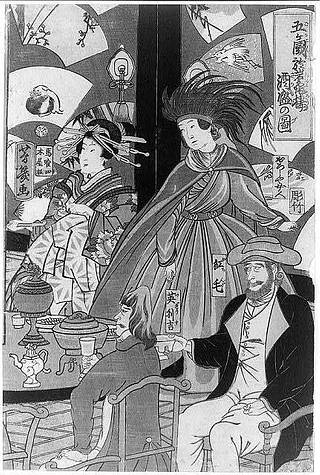
Gokakoku ... gankirō ni oite sakamori no zu
Summary
Japanese triptych print shows visitors from several nations enjoying a party in the Fan Room of the Gankirō.
Signature: Ikkeisai Yoshiiku ga.
Engraving attributed to: Hori Take.
Seal date: Monkey 12.
Triptych in 3 sections (matted together): right (101a), center (101b), left (101c).
Annotations, stamps, etc. on verso of print: 75; 47623a (white label).
Yokohama : prints from nineteenth-century Japan / Ann Yonemura. Washington, D.C. : Arthur M. Sackler Gallery : Smithsonian Institution Press, c1990, no. 59 (p. 149)
The Floating world of Ukiyo-e: shadows, dreams and substance / essays by Sandy Kita ... [et al.]. New York: Harry N. Abrams, in association with the Library of Congress, 2001, no. 106, p. 171
Earlier control number: 9942.1-7.
Gift; Mrs. E. Crane Chadbourne; 1930; (DLC/PP-1930:47623a).
Forms part of: Chadbourne collection of Japanese prints (Library of Congress).
Exhibited: "The Floating world of Ukiyo-e: shadows, dreams and substances," organized by the Library of Congress, 2001.
Exhibited: "Steeped in History : The Art of Tea" at the Fowler Museum, University of California, Los Angeles, 2009.
Woodblock printing in Japan (木版画, moku-hanga) is a technique best known for its use in the ukiyo-e artistic genre of single sheets, but it was also used for printing books in the same period. Woodblock printing had been used in China for centuries to print books, long before the advent of movable type, but was widely adopted in Japan during the Edo period (1603-1868). Woodblock printing appeared in Japan at the beginning of Edo period, when Tokugawa shogunate was ruled by the Japanese society. This technique originated from China, where it was used to print books for many centuries. Its original name is ‘moku-hanga’ and it has a wide usage in artistic genre of ‘ukiyo-e’. As opposed to western tradition, where artists used oil-based inks for woodcuts, moku-hanga technique uses water-based inks. That is why those prints had colors so vivid, as well as glazes, and transparency. This collection describes Japanese printmaking different schools and movements. The most notable of them were: - From 1700: Torii school - From 1700-1714: Kaigetsudō school - From 1720s: Katasukawa school, including the artists Shunsho and Shuntei - From 1725: Kawamata school including the artists Suzuki Harunobu and Koryusai - From 1786: Hokusai school, including the artists Hokusai, Hokuei and Gakutei - From 1794: Kitagawa school, including the artists Utamaro I, Kikumaro I and II - From 1842: Utagawa school, including the artists Kunisada and Hiroshige - From 1904: Sōsaku-hanga, "Creative Prints" movement - From 1915: Shin-hanga "New Prints" school, including Hasui Kawase and Hiroshi Yoshida Woodblock prints were provided by the Library of Congress and cover the period from 1600 to 1980.
Tags
Date
Contributors
Location
Source
Copyright info
































